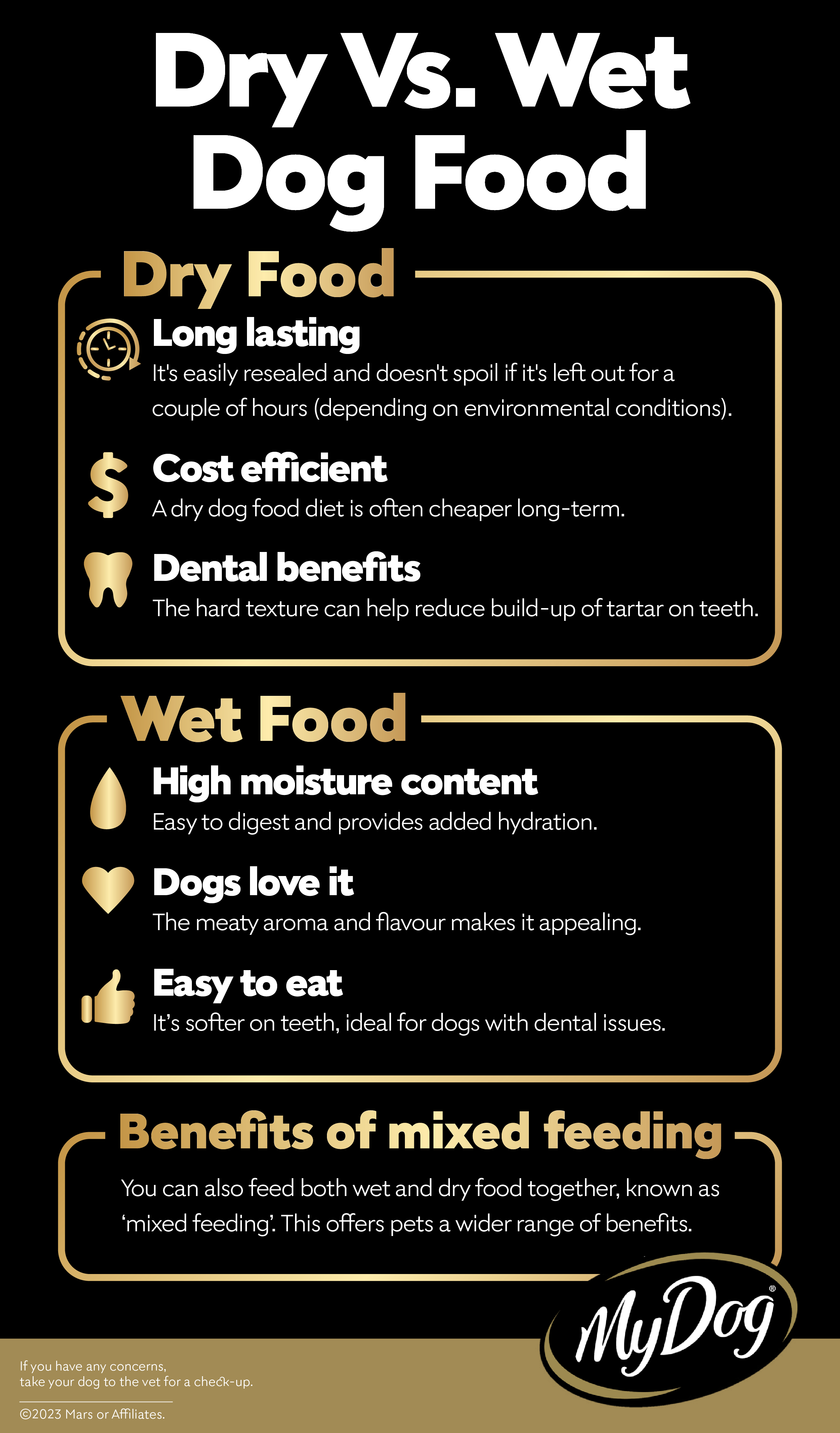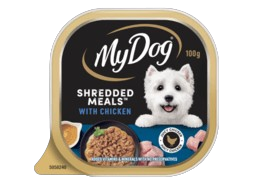

We all want the very best for our beloved pooches and that includes the food they eat. One of the main decisions we have to make as dog parents is whether to feed them dry or wet dog food. Each one has its pros and cons, and with so many options available, it can be hard to pick. By understanding your dog’s dietary needs and how the two types of food differ, you can choose which is best for your furry friend.
What's the difference between dry vs wet dog food?
Dry and wet dog food can both provide your dog with the complete nutrition they need, but each have their own qualities, so may suit different dogs and pet families. Dry dog food comes in the form of a crunchy kibble and is the most common choice among Australian pet parents. Wet dog food usually comes in a can or sealed pack and more closely resembles the softer texture of its original ingredients, including meat and vegetables. Some come as a smooth pate, like the MY DOG® Classic Loaf range, whereas some come in a juicy gravy, like MY DOG® Fillets in Gravy others even resemble wholesome home-cooked meals, like MY DOG® Home Delights™.
How dry food is processed
Dry dog food is made by combining meat, grains, vitamins, and minerals and grinding them into a dough. The mixture is then cooked at a high temperature and shaped into kibble pellets, at which point it’s sprayed with oils, fats, minerals, and vitamins, before being dried and packaged.
How wet food is processed
Wet food is made by grinding the meat or fish and cooking it at a high temperature to kill bacteria. It’s then combined with a gravy that contains vegetables, vitamins, minerals, and grains, before being sealed to preserve its freshness.

The pros and cons of dry food
The pros
- Long lasting - Bags of dry food can easily be resealed with a clip, without the need for refrigeration. It lasts a long time without preservatives and also doesn’t spoil if it’s left out all day.
- Cost efficient - Depending on the brand, a dry dog food diet is often cheaper in the long term.
- Dental benefits - Dry dog food encourages dogs to chew their food more, which can help prevent build-up of tartar on their teeth.
The cons
- Processing can impact nutrients - The high temperature that dry dog food is cooked at can break down the nutritional value of some ingredients.
- Lacks moisture - Dry dog food doesn’t offer the same level of moisture as wet food, which is good for hydration and digestion. This said, varieties of semi-moist kibble, such as MY DOG® Semi-Moist Kibble, are soft and chewy and contain more moisture than regular kibble.
The pros and cons of wet food
The pros
- Higher moisture content - The moisture in wet food makes it easier to digest, helping to prevent constipation while also supporting urinary tract health.
- Rich aroma and flavour - The meaty smell and flavour of wet food makes it more appealing to dogs, so may be a good choice for picky eaters or sick and older dogs that are off their food.
- Easy to eat - The smooth, soft consistency of wet food makes it easier to eat for dogs with dental issues.
The cons
- Shorter shelf life - Its high moisture content means it needs to be refrigerated once it’s opened and eaten within a few days.
- Not as cost efficient - Depending on the brand, a wet food diet can cost more than dry food in the long term.
Understanding your dog's dietary needs
It’s important that you make sure your pup is getting a well-balanced diet that contains all the nutrients they need to be healthy and happy. Both dry and wet dog food can offer them complete nutrition, but specific dietary requirements and other health needs might mean your pup is better suited to one over the other. Factors such as health, age, weight, and activity level can all come into play, so if you’re unsure what is best for your furry friend, have a chat with your vet for advice.
Making a decision
Choosing dry or wet dog food comes down to your pup's particular needs and your personal preference. Each type has their own advantages, based on cost, convenience and health, but ultimately, the most important thing is to feed your furry friend high-quality food that meets their unique needs and tastes great. It’s also important to make sure you’re feeding them the recommended amount, factoring in any treats they get throughout the day. Always be careful what you feed your pup, as many human foods are toxic for dogs or can contribute to weight gain and other health issues.
Mixing dry and wet food
This all said, you don’t necessarily need to choose one or the other. Many pet parents feed their pooch a diet of dry and wet food combined, as it offers the best of both worlds. If you decide to do this, just make sure you calculate how much your dog should be eating each day, so you don’t end up over feeding them. Making a choice between dry vs wet food can feel confusing, but hopefully the above breakdown has made it a little easier to decide what could be the best choice for your pup. For more advice on dog nutrition and other tips on keeping them happy and healthy, check out our blog.
@2023 Mars or Affiliates.
Buy online
Click to buy from any of the retailers below





